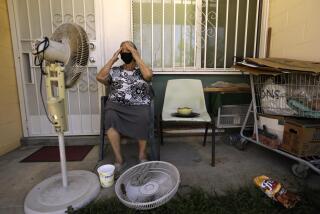INTERIORS : Fans Provide a Cool Way of Keeping Heat Away
- Share via
An electric fan can keep you cool despite summer’s heat. A fan increases airflow in a room, helping to evaporate your body’s perspiration.
There are two basic types:
* A circulating fan: ceiling, fixed or oscillating, or floor-level hassock type, moves the air around within a room.
* A ventilating fan: most effective for overall home cooling, changes the air in the room by blowing out and drawing in fresh air.
When used with an air conditioner, a ceiling fan can make less cooling feel like more. In summer, counterclockwise blade rotation circulates cooling breezes. Operated in reverse in winter, a ceiling fan can reclaim heat by returning the rising warm air to floor level. Locate a ceiling fan so that its blades are at least one foot below the ceiling, seven feet above the floor and two feet from the nearest wall.
Ventilating fans can be portable, fixed in place in a window or installed in an attic. Position a box fan or a fixed window fan to blow out hot air. For cross-ventilation, open windows only in rooms you wish to cool.
Usually centrally located in the attic, a whole-house fan pulls hot indoor air into the attic and exhausts it through vents. Cool night air is drawn in through selectively opened doors and windows, and the house is cooled at a fraction of the cost of air conditioning.
*
The most common type of attic fan is installed in the ceiling beneath the attic and pulls air directly from the living area into the unused space above. The attic air then moves oubtdoors through ventilating louvers, usually installed in the gable ends of the house.
A whole-house fan should change the air in the house every two minutes.
To get the right size, calculate the volume of all rooms to be cooled: multiply height by width by length of each room and add the totals. Divide by two to obtain the “design airflow rate” in cubic feet per minute (CFM).
Check that the attic vents have at least one square foot of free area for every 750 CFM of airflow. Add more or larger vents if they do not.
Always open at least one exterior door or window before operating a whole-house fan.
For best results, open windows and doors of rooms that are in use.
Most whole-house fans have 12-hour timers and speed-control switches. Some have thermostats too.
